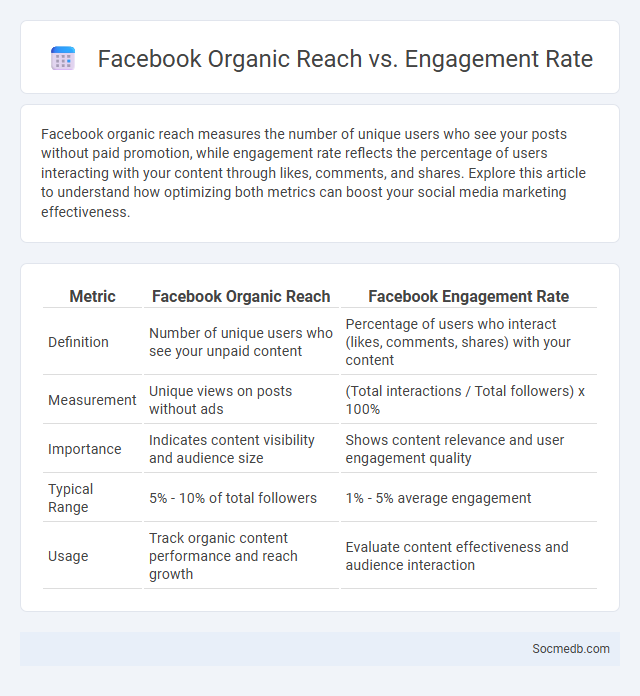
Photo illustration: Facebook Organic Reach vs Engagement Rate
Facebook organic reach measures the number of unique users who see your posts without paid promotion, while engagement rate reflects the percentage of users interacting with your content through likes, comments, and shares. Explore this article to understand how optimizing both metrics can boost your social media marketing effectiveness.
Table of Comparison
| Metric | Facebook Organic Reach | Facebook Engagement Rate |
|---|---|---|
| Definition | Number of unique users who see your unpaid content | Percentage of users who interact (likes, comments, shares) with your content |
| Measurement | Unique views on posts without ads | (Total interactions / Total followers) x 100% |
| Importance | Indicates content visibility and audience size | Shows content relevance and user engagement quality |
| Typical Range | 5% - 10% of total followers | 1% - 5% average engagement |
| Usage | Track organic content performance and reach growth | Evaluate content effectiveness and audience interaction |
Understanding Facebook Organic Reach
Facebook organic reach measures the number of unique users who see your content without paid promotion, influenced primarily by the platform's algorithm prioritizing meaningful interactions. Factors such as post type, timing, and audience engagement critically affect organic visibility, with video and live content typically achieving higher reach. Monitoring insights and adapting content strategies to align with Facebook's evolving algorithm enhances organic reach effectiveness and audience engagement.
Defining Engagement Rate on Facebook
Engagement rate on Facebook measures the level of interaction users have with posts, calculated by dividing total engagements (likes, comments, shares, clicks) by the total number of followers or reach, then multiplying by 100 to get a percentage. A high engagement rate indicates strong audience interest and content relevance, which boosts visibility in Facebook's algorithm-driven newsfeed. Brands and marketers use this metric to evaluate content performance, optimize strategies, and increase audience connection on the platform.
Key Differences: Reach vs Engagement
Reach measures the total number of unique users who see a social media post, highlighting the potential audience size and brand exposure. Engagement refers to the interactions users have with the content, such as likes, comments, shares, and clicks, indicating the level of audience involvement and interest. While reach emphasizes breadth and visibility, engagement focuses on depth and quality of user interaction.
How Facebook’s Algorithm Affects Reach and Engagement
Facebook's algorithm prioritizes content that generates meaningful interactions, directly impacting your post's reach and engagement by favoring posts from friends, family, and groups over pages and businesses. It uses machine learning to analyze user behavior, showing content more likely to receive reactions, comments, and shares, thereby increasing visibility. Understanding this algorithm helps you tailor your content strategy to maximize organic reach and foster a more engaged community.
Why Organic Reach Matters for Brands
Organic reach remains crucial for brands as it fosters genuine connections with audiences without relying on paid advertising, enhancing trust and brand loyalty. High organic reach signals to social media algorithms that content is valuable, increasing visibility and engagement among target demographics. Brands leveraging organic reach benefit from sustained, cost-effective exposure, amplifying their influence and driving long-term customer relationships.
Importance of Tracking Engagement Rate
Tracking engagement rate on social media provides critical insights into how audiences interact with content, revealing the relevance and effectiveness of posts. Higher engagement rates often correlate with increased brand awareness, customer loyalty, and improved conversion rates. Analyzing metrics such as likes, comments, shares, and saves enables marketers to optimize strategies, tailor content, and maximize return on investment.
Common Misconceptions about Reach vs Engagement
Many users mistakenly believe high reach guarantees strong engagement, but a large audience doesn't ensure meaningful interactions such as likes, comments, or shares. Algorithms prioritize content that fosters engagement, meaning posts with lower reach can still achieve higher engagement rates if they resonate with the audience. Understanding the distinct metrics of reach (total viewers) versus engagement (interactive responses) is crucial for effective social media strategy.
Strategies to Improve Organic Reach
Optimizing social media algorithms through consistent posting schedules and engaging content tailored to target audiences significantly boosts organic reach. Leveraging user-generated content and interactive features like polls and stories increases audience participation, enhancing visibility across platforms. Prioritizing SEO-friendly captions and relevant hashtags also improves discoverability and drives higher organic engagement rates.
Boosting Your Engagement Rate Organically
Boosting Your engagement rate organically on social media requires creating authentic, valuable content that resonates with your audience. Utilize targeted hashtags and engage genuinely by responding to comments, encouraging conversations, and sharing user-generated content. Consistency in posting and leveraging platform-specific features like Stories and Reels will also help increase visibility and foster deeper connections with Your followers.
Measuring Success: Which Metric Should You Prioritize?
Engagement rate remains the most powerful metric to prioritize when measuring social media success, as it directly reflects audience interaction and content relevance. Tracking metrics like click-through rate, follower growth, and conversion rate provides comprehensive insights, but engagement offers the clearest indicator of active community interest. Businesses should align their key performance indicators (KPIs) with specific campaign goals to ensure meaningful analysis and strategic decision-making.
 socmedb.com
socmedb.com